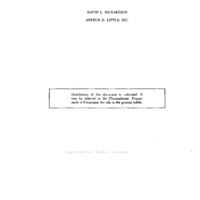-
Title
-
Techniques And Materials For Passive Thermal Control Of Rigid And Flexible Extravehicular Space Enclosures
-
Date
-
1967
-
Index Abstract
-
Not Available
-
Photo Quality
-
Complete
-
Report Number
-
AMRL TR 67-128
-
Creator
-
Richardson, David L.
-
Corporate Author
-
Little (Arthur D) Inc Cambridge Mass
-
Laboratory
-
Aerospace Medical Research Laboratories
-
Date Issued
-
1967-12-01
-
Extent
-
120
-
Identifier
-
AD0666940
-
Access Rights
-
Distribution of this document is unlimited. It may be released to the Clearinghouse, Department of Commerce, for sale to the general public.
-
Distribution Classification
-
1
-
Contract
-
AF 33(615)-3533
-
DoD Project
-
7164
-
DoD Task
-
716412
-
DTIC Record Exists
-
No
-
Distribution Change Authority Correspondence
-
None
-
Distribution Conflict
-
No
-
Abstract
-
The results of the analysis indicate that when an astronaut in a flexible enclosure (soft space suit) works on the surface of a large spacecraft, the temperatures on his external surface are markedly increased over those which occur when he is not near the spacecraft. Moreover, passive thermal control of the astronaut is not possible when he is near the spacecraft. The techniques investigated for thermally coupling an astronaut with his thermal control system include liquid cooled undergarments, gas cooling, and heat transfer to the cooled walls of his enclosure. Techniques were investigated for increasing the conductance through soft space suit insulations by compressing the insulation. The insulation of a cylindrical section of a space suit arm was measured under both compressed conditions (3.7 psia) and uncompressed conditions in simulated noon and earth-umbra orbit-positions. The range of conductance increased from 0.26 Btu/sq ft-hr degrees F uncompressed to 0.81 Btu/sq ft-hr degree F compressed. Measurements were made in simulated noon and earth-umbra orbit positions of the thermal heat dissipating capability of a louver system which was designed for operation in the sun. A 6-inch square model had a net heat flow from the louvers for the four orbit conditions tested (open and closed in the sun and in the shade). The louver operation controls maintained the louver baseplate temperature in the range from 73.9 to 84.7 F for a steady heat dissipation rate of 95.5 Btu/sq ft-hr while operating in the shade.
-
Report Availability
-
Full text available
-
Provenance
-
Lockheed Martin Missiles & Fire Control
-
Type
-
report
-
Format
-
1 online resource
 AMRLTR67-128.pdf
AMRLTR67-128.pdf